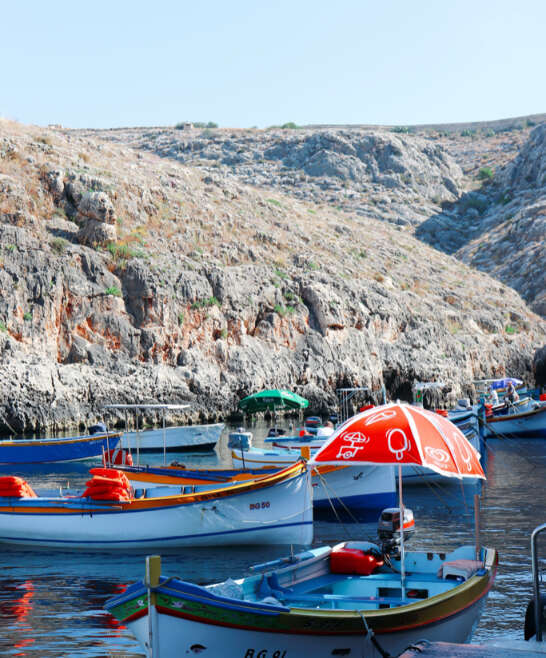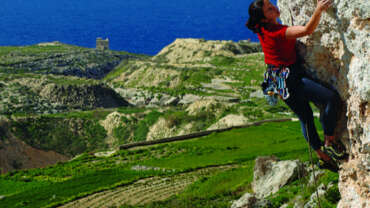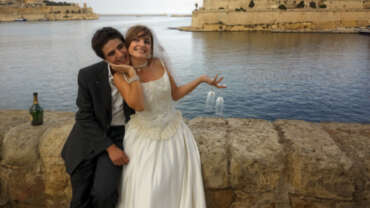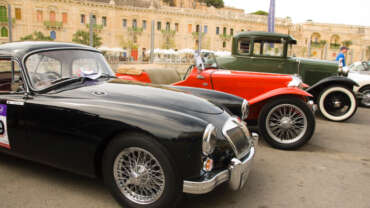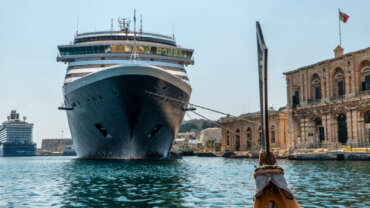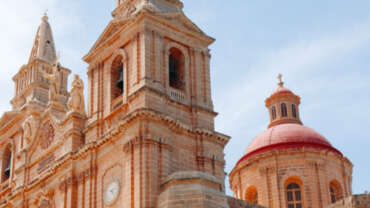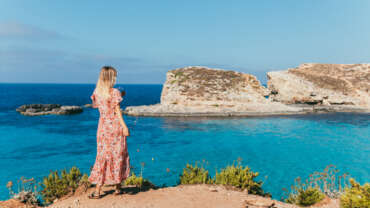Places to visit in Malta
The Maltese Archipelago is made up of a number of Islands. Three of these are inhabited – Malta, the largest, which may be considered as being to some extent the ‘mainland’, Gozo – number two in terms of size, and tiny Comino. There are other islands – Cominotto, Filfla, St. Paul’s Islands and Manoel Island – which are even smaller and uninhabited.
Although the territory covered collectively by the abovementioned islands is just over three hundred square kilometres, the country is densely populated, and presents a contrasting array of landscapes and localities.
There’s the historic capital city of Valletta – the island’s commercial and administrative centre – and the famous Three Cities across the Grand Harbour. There is the Sliema/St. Julian’s/Paceville area, renowned for its cosmopolitan feel and lively nightlife. There are the coastal resorts of the north, the picturesque villages of the south and the rural centre. Every town and village has something special to offer…including its colourful annual ‘festa’.
Then there are attractions of every kind – from historical to natural, from religious to family fun. The beaches and bays of Malta and Gozo – many of which are refreshingly undeveloped – are surrounded by some of the cleanest waters in the Mediterranean.
Islands
The Maltese archipelago lies virtually at the centre of the Mediterranean, 93 km south of Sicily and 288 km north of Africa.
The archipelago consists of three islands: Malta, Gozo and Comino with a total population of over 400,000 inhabitants occupying an area of 316 square kilometers.
Malta is the largest island and the cultural, commercial and administrative centre.
Gozo is the second largest island and is more rural, characterised by fishing, tourism, crafts and agriculture.
Comino, the smallest of the trio, has one hotel and is largely uninhabited.
Malta
Malta is the largest island and the cultural, commercial and administrative centre.
Here you can span the millennia with an astonishing array of things to discover. And wherever you go, the scenery and architecture provide a spectacular backdrop. The colours are striking, honey-coloured stone against the deepest of Mediterranean blues.
Malta has been described as one big open-air museum. What makes it unique is that so much of the past is visible today. Delve into the island’s mysterious prehistory, retrace the footsteps of St. Paul or see where the Knights of St. John fought their most famous battles.
Malta is holidaying as the mood takes you. And with near year-round sun, you can indulge in outdoor living at its best.
In just a kilometre or two, you can try a new sport, laze on an island cruise and tour the most important historic sites, and still have time to join in the nightlife. That’s the real advantage of a stay here.
The island offers plenty of specialist holidays for those seeking to brush up their English, learn a new skill, discover history or get fit. If you’re interested in sports, there’s enough on offer to satisfy the seasoned enthusiast as well as the casual first-timer. Malta has wellness and spa facilities at the luxury hotels and club resorts. Sea and land lend themselves to activities from rock-climbing to gentle rambling.
And, if this were not enough, there are the other two islands – Gozo and Comino -which can be a pleasant change-of-scene during your stay on the mainland or alternative destinations in themselves. The choice is yours…
Gozo
Gozo is known to provide a tranquil haven for a tempo and scene change. The charm of Malta’s sister Island is immediately apparent; it’s greener, more rural and smaller, with life’s rhythms dictated by the seasons, fishing and agriculture.
Steeped in myth, Gozo is thought to be the legendary Calypso’s isle of Homer’s Odyssey – a peaceful, mystical backwater. Baroque churches and old stone farmhouses dot the countryside. Gozo’s rugged landscape and spectacular coastline await exploration with some of the Mediterranean’s best dive sites.
The island also comes complete with historical sites, forts and amazing panoramas, as well as one of the archipelago’s best-preserved prehistoric temples, Ġgantija.
Gozo also possesses a nightlife and cultural calendar all of its own, with some great dining out.
Comino
Situated between Malta and Gozo, the smaller island of Comino is a paradise for snorkelers, divers, windsurfers and ramblers.
Only 3.5 square kilometers, Comino is car-free and apart from one hotel, is virtually uninhabited.
The island’s main attraction is the Blue Lagoon. In summer, this sheltered inlet of shimmering aquamarine water over white sand is very popular with day-trippers. Other beaches on the island include Santa Marija Bay and San Niklaw Bay.
Comino is also worth a visit in winter, and is ideal for walkers and photographers. With no urban areas or cars on the island, one can easily smell the scent of wild thyme and other herbs.
Comino was inhabited in the Roman period, but did not have much significance until the Knights arrived. It then had a dual role: hunting grounds and a staging post in the defence of the Maltese Islands against the Ottoman Turks.
The island had proved a useful base for pirates operating in the central Mediterranean and, though stark and barren today, it was home to wild boar and hares when the Knights arrived in 1530. The Grandmasters went to great lengths to ensure that their game on Comino was protected: anyone found breaking the embargo on hunting could expect to serve three years rowing on a galley.
After WWII, Comino remained a backwater until its fortunes revived with tourism in the mid-1960s.
Valletta
Valletta, The Fortress City, Citta’ Umilissima, “a city built by gentlemen for gentlemen” is Malta’s capital city: a living, working city, the administrative and commercial heart of the Islands. Valletta is named after its founder, the respected Grand Master of the Order of St. John, Jean Parisot de la Valette. The magnificent fortress city grew on the arid rock of Mount Sceberras peninsula, which rises steeply from two deep harbours, Marsamxett and Grand Harbour. Started in 1566, Valletta was completed, with its impressive bastions, forts and cathedral, in the astonishingly short time of 15 years, even more remarkable is considering the fact that mechanical tools did not exist at the time and the whole city was built entirely by hand.
Valletta has many titles, all recalling its rich historical past. It is the “modern” city built by the Knights of St John; a masterpiece of the Baroque; a European Art City and a World Heritage City. Today, it is one of the most concentrated historic areas in the world.
The city is busy by day, yet retains a timeless atmosphere by night, that gives the feeling that you are walking back in time. The grid of narrow streets boasts some of Europe’s finest art works, churches and palaces.
Valletta is abundantly rich in sites to see and explore, intriguing historical buildings around every corner: votive statues, niches, fountains and coats of arms high up on parapets. Narrow side streets are full of tiny quaint shops and cafés, while Valletta’s main streets are lined with larger international branded shops for fashion, music, jewellery and much more.
The best way to get around and see the most, from your visit to Valletta, is on foot and although the things to do & see are many, a good start and definitely not to be missed are Valletta’s beautiful gardens. The Upper Barrakka Gardens, Hastings Gardens & the Lower Barrakka Gardens are just three of the most popular ones, however on further exploration many more hidden gardens can be discovered. From the Upper Barrakka Gardens it is also possible to see the Saluting Battery as well as take the lift down the bastions to sea level.
St John’s co-Cathedral & museum are definitely not to be missed, this elaborately adorned church is home to world famous artistic masterpieces by Caravaggio and Mattia Preti. Apart from beautiful Baroque churches other places of interest include the various grandmaster auberges, piazzas & museums.
Towns & Villages
There are walled cities and baroque towns, sleepy villages and bustling fishing ports. Then there is modern, urban living with cafés, nightlife, clubs and restaurants.
There are places in which to live it up and others where it seems like time stood still. In Malta you can enjoy life at its simplest one day and at its most cosmopolitan the next. However short your stay, it’s possible to have a taste of island life in a variety of settings – from traditional villages to urban resorts.
Malta’s capital, the World Heritage City of Valletta, and the medieval fortified towns of Mdina and Cittadella in Gozo, are the Islands’ historical highlights. Tas-Sliema, Bugibba, Qawra and St. Julian’s in Malta and Marsalforn and Xlendi in Gozo are the main resorts. They bustle with activity, and not just in summer.
Valletta is a treasurehouse of art and architecture. This city of the Knights remains virtually intact, its streets flanked by palaces and tiny, old-world shops. Across Grand Harbour lie the Three Cities of Senglea, Cospicua and Vittoriosa. Older than Valletta, they offer a fascinating insight into the islands’ maritime fortunes.
The southern fishing village of Marsaxlokk and neighbouring resort town of Marsascala are also worth a visit.
With little effort, just a desire to explore, you’ll find inland towns and villages with character and treasures of their own. Churches reveal masterpieces by the artists to the Knights while each village square is a slice of history, its café-bar the hub of authentic rural life.
Mdina & Rabat
The history of Mdina traces back more than 4000 years. According to tradition it was here that in 60 A.D. that the Apostle St. Paul is said to have lived after being shipwrecked on the Islands. Furthermore it is said that St. Paul resided inside the grotto know as Fuori le Mura (outside the city walls) now known as St. Paul’s Grotto in Rabat. Lamp lit by night and referred to as “the silent city”, Mdina is fascinating to visit for its timeless atmosphere as well as its cultural and religious treasures.
Mdina has had different names and titles depending on its rulers and its role but its medieval name describe it best – ‘Citta’ Notabile’: the noble city.
It was home then, as now, to Malta’s noble families; some are descendants of the Norman, Sicilian and Spanish overlords who made Mdina their home from the 12th century onwards. Impressive palaces line its narrow, shady streets.
Mdina is one of Europe’s finest examples of an ancient walled city and extraordinary in its mix of medieval and baroque architecture.
Like nearby Mdina, Rabat played a major role in Malta’s past and is a prime source of its cultural heritage.
This large provincial township was part of the Roman city of Melita, with the sites and archaeological relics found testifying to the town’s importance during the Roman period.
For many centuries, religious orders have established themselves within the precincts of Rabat and Franciscans, Dominicans and Augustinians still flourish here in their spacious convents and monasteries, catering for the religious needs of parishioners in their churches.
The town is a commercial centre and acts as a market to its large agricultural hinterland. It is also well established on the tourist map due to its archaeological and historical sites: The Roman Villa (Domus Romana), catacombs, St. Paul’s Grotto and the fine churches and monasteries.
The Three Cities
The Three Cities offer an intriguing insight into Malta and its history. Left largely unvisited, these cities are a slice of authentic life as well as a glimpse into Malta’s maritime fortunes.
The Three Cities can rightly claim to be the cradle of Maltese history, as Vittoriosa, Senglea and Cospicua have provided a home and fortress to almost every people who settled on the Islands.
Their harbour inlets have been in use since Phoenician times: the docks always providing a living for local people, but also leaving them vulnerable when Malta’s rulers were at war. As the first home to the Knights of St. John, the Three Cities’ palaces, churches, forts and bastions are far older than Valletta’s.
The local communities here celebrate holy days and festas as nowhere else on the Islands. The most spectacular events are the Easter processions when statues of the “Risen Christ” are carried at a run through crowded streets.
The Three Villages
Lying between the old medieval capital city of Malta, Mdina, and the Baroque capital city, Valletta, lies the so-called Three Villages, namely Ħ’Attard, Ħal Lija and Ħal Balzan. The present combined population of these three villages does not exceed more than 18,000 people, although this increase is the result of modern buildings around the periphery of the Three Villages.
Walking the streets of these villages one gets the impression of going back in time, with the well-kept alleys, the restored noble palaces, and the beautiful parish churches and other interesting features.
The walk will take one through parts of the area, although everyone is invited to explore the whole area and be enchanted by the unique villages of Ħ’Attard, Ħal Lija and Ħal Balzan.
Victoria & Cittadella
All roads in Gozo lead to Rabat, also known as Victoria. The Citadel is visible from almost all the Island, rising steeply above the surrounding countryside.
The Citadel in Gozo owes its roots to the late medieval era, but the hill has been settled since Neolithic times. For centuries, the Citadel served as a sanctuary from attack by Barbary corsairs and Saracens. At several times during Gozo’s history, these raiders took its population into slavery.
After the Great Siege of 1565, the Knights set about re-fortifying the Citadel to provide refuge and defence against further attack. Until 1637, the Gozitan population was required by law to spend their nights within the Citadel for their own safety. In later, more peaceful times, this restriction was lifted and people settled below its walls, creating the prosperous town of Rabat, now known as Victoria.
Victoria is not just the geographic heart of Gozo, it is also the centre of everyday activity. It manages to combine the bustle of its market and shops with a relaxed and sociable atmosphere. It is a great place to watch the Islanders go about their day, especially when the main market square, It-Tokk, comes to life.
Browse around Victoria’s market and narrow winding streets and you’ll find everything from delicious fresh produce, cheeses and wines, to antiques, craft goods, fishing nets and knitwear. The town also has a thriving cultural life all its own, with some surprising attractions ranging from opera to horse races in the main street on festa day.
Resorts & Regions
The North, the most rugged of all Malta’s regions, offers spectacular views across to Comino and Gozo. It also has Malta’s most established beach and holiday resorts, Buġibba, Qawra, St. Paul’s Bay, and Malta’s largest sandy beach at Mellieħa. Also northwards are Malta’s other larger sandy bays, Golden Bay, Għajn Tuffieħa and Paradise Bay.
Sliema and St. Julian’s are Malta’s main coastal resort towns and a heartland for shopping, entertainment and café life. They also house some of Malta’s newest hotels and apartments. St. Julian’s and Paceville are Malta’s main nightlife areas.
The South is characterised by its fishing villages and quiet bays. It offers an authentic insight into Maltese rural life. It is also the location of two of Malta’s prehistoric temples, Ħagar Qim and Mnajdra. The region is largely undeveloped. Most hotels are in the harbour town of Marsaskala, a southern resort which bustles by night yet is charming and quiet by day.
Central Malta is dominated by Malta’s ancient capital, Mdina, a near perfect example of a medieval walled town. Beyond the walls, lies Rabat, a large town of Roman origin. The central region has some of the most interesting inland options, ranging from palaces to town house hotels.
Malta’s sister islands of Gozo and Comino provide a tranquil haven and scene change. Greener, more rural and smaller than Malta, life on Gozo moves at a leisurely pace. Accommodation options here range from charming old farmhouses, often with private pools, to five-star hotels and apartments with spectacular sea views, to secluded hotels with stone trulli and cottages as guest quarters.
Tiny Comino is the ultimate escape, all year round. Car-free and carefree, it has just the one resort hotel but it makes an excellent choice for those who want seclusion or to make the most of water sports.
Towns, Villages and Hamlets
Worlds apart from the main resorts and the capital Valletta, are the Islands’ villages. They are the epitomé of Mediterranean life. The soul of the Islands’ past. Yet, with their lively festas and unique everyday life, they are very much part of the Islands’ culture today.
Even the smallest village has its own baroque wonder, the parish church. And to locals, each village has its unique character. After visiting a few, you’ll soon pick up on the differences.
Some are known for their festas and traditions, others are national gems as they house archaeological or architectural treasures. Then there are the seaside villages, where the rhythm of life is dictated by fishing. While life in inland villages is determined by the harvesting of the various fruits and vegetables grown nearby.
The oddity about the islands’ villages is their size. A village is not defined by the number of residents or streets. The description really dates back to a time when village boundaries were defined by parishes. Some of the larger ones, like Ħaż-Żebbuġ in central Malta are still referred to as villages.
Malta also has its ‘Three Villages’, rather like its Three Cities of Vittoriosa (Il-Birgu), Cospicua (Bormla) and Senglea (L-Isla). The Three Villages are Ħ’Attard, Ħal Balzan and Ħal Lija in central Malta. During the Golden Age of Malta, after the Great Siege, many noble families built houses here, and identified the villages with a semi-urban sophistication.
While the size of Malta’s villages may vary, those in Gozo are usually small and life here is mostly centred on the activities of the parish and community.



